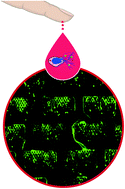Microfluidic capture of chromatin fibres measures neutrophil extracellular traps (NETs) released in a drop of human blood†
Abstract
Neutrophils are the largest population of white blood cells in the circulation, and their primary function is to protect the body from microbes. They can release the chromatin in their nucleus, forming characteristic web structures and trap microbes, contributing to antimicrobial defenses. The chromatin webs are known as neutrophil extracellular traps (NETs). Importantly, neutrophils can also release NETs in pathological conditions related to rheumatic diseases, atherosclerosis, cancer, and sepsis. Thus, determining the concentration of NETs in the blood is increasingly important for monitoring patients, evaluating treatment efficacy, and understanding the pathology of various diseases. However, traditional methods for measuring NETs require separating cells and plasma from blood, are prone to sample preparation artifacts, and cannot distinguish between intact and degraded NETs. Here, we design a microfluidic analytical tool that captures NETs mechanically from a drop of blood and measures the amount of intact NETs unbiased by the presence of degraded NETs in the sample.

- This article is part of the themed collection: Microfluidics for hematology


 Please wait while we load your content...
Please wait while we load your content...